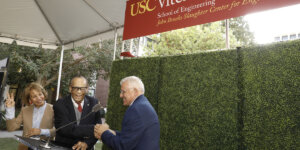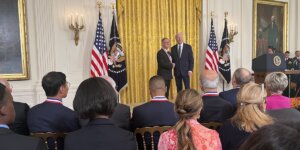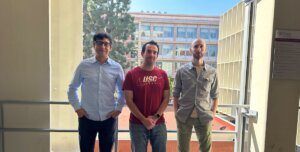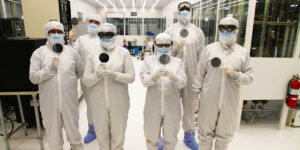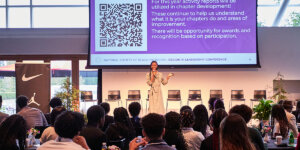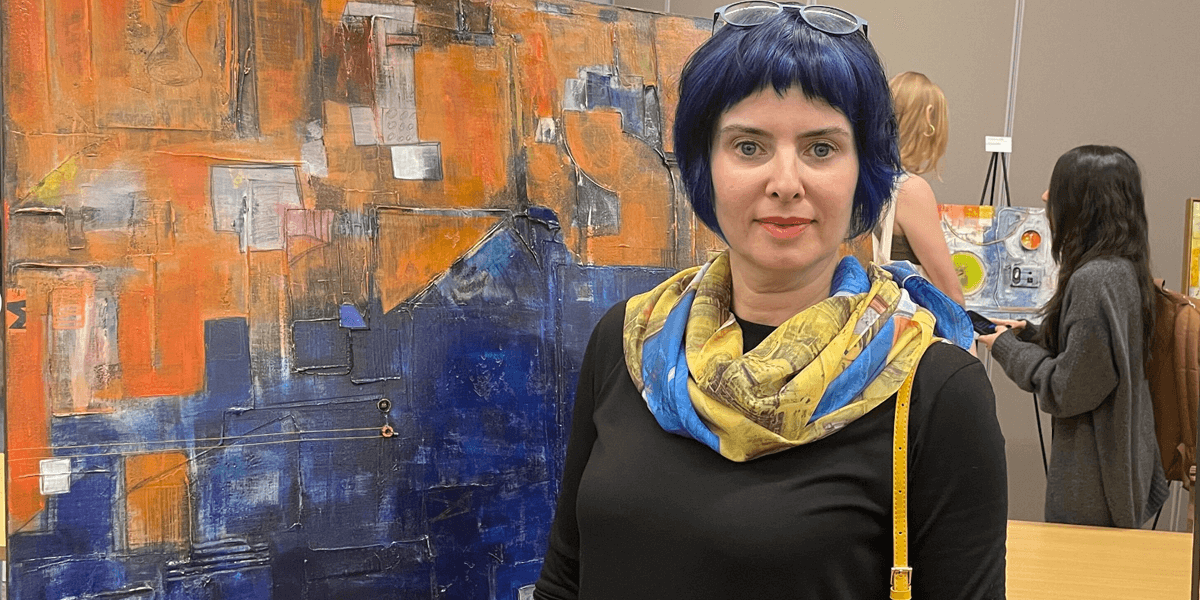
Lina Kogan stands in front of one of the many pieces displayed during the Current exhibition. Photo/Lina Kogan.
USC students and faculty gathered in the USC Michelson Center for Convergent Bioscience Jan. 25 for “Current,” the exhibition of Ukrainian-born artist, computer scientist, and USC Viterbi alumna Lina Kogan, who graduated in 2000 with a master’s degree in computer science and multimedia and creative technologies. Her work combines minimalism with computers—literally. Computer chips, keyboard keys and wires weave their way throughout Kogan’s works, bringing a distinctly technological look to the canvases.
Kogan, also a professional computer scientist, merges art and technology in her pieces as a matter of habit. The bits of tech embedded in canvases throughout the room are allegories to her past, pastiches of her experience growing up in the Eastern Bloc.
Back in Kyiv, Kogan went to art school as a child. However, when it came time to leave for college, her parents pushed her towards a technical degree—engineering, computer science—because she’d shown an aptitude for math.
“I loved painting and creating from an early age,” Kogan said. “But I was kind of steered away from it— away from art.”
When Kogan came to the United States in 1992 at 20 years old to continue her education, this passion was still alive and well. While working towards her master’s degree at USC, she also took on ceramics, drawing, painting and sculpture classes in addition to her courses, cultivating an interest in sculpture and reigniting her fervor for creating.
“I just loved the three-dimensional part of it,” Kogan said. “I was creating again, sculptures and ceramic art, and that’s how all this started.”
Since 2005, Kogan has been exhibiting her work at museums, art galleries and auctions, all the while working full-time in Information Technology with Aerojet Rocketdyne.
Source Code What do you Hear
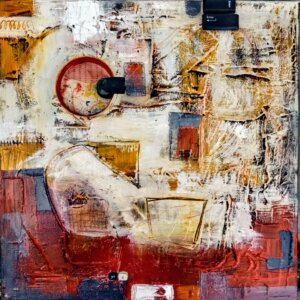
Lina Kogan’s titular piece, “Source Code”
The title of the exhibition, “Current,” is very relevant to a specific piece, according to Kogan. She showed the piece, titled “Source Code What do you Hear,” during her presentation at the start of the event alongside the definition of “Current,” highlighting the fact that it refers to both a moment in time and an electrical charge. The titular work is awash with an intense red hue that sinks to the bottom of the canvas and is interspersed with keys, metal piping, and an archaic-looking computer punch card.
“It goes back to the history of computing. I got that card from the Museum of the History of Computing in Santa Clara,” Kogan said. “It’s symbolic to me, because my mom used punch cards at her job as a software engineer and would bring the used ones home, and we wrote messages to each other on them, back in Kyiv. It’s very generational; How do we respond to events from the past? How does that translate to today? What is the connection between old and new?”
The keys at the bottom seem at a glance to be random letters strung together, but in fact spell the Slavic word for ear in the Cyrillic alphabet, yxo, bringing an extra meaning to the various bits and baubles.
“The title is self-explanatory; sometimes messages get lost in translation,” Kogan said. “Sometimes technology helps us get the message across, but other times we’re so bombarded by various stimuli from this technology that it can make us lose focus, and we might miss important messages because of that.”
Landscape
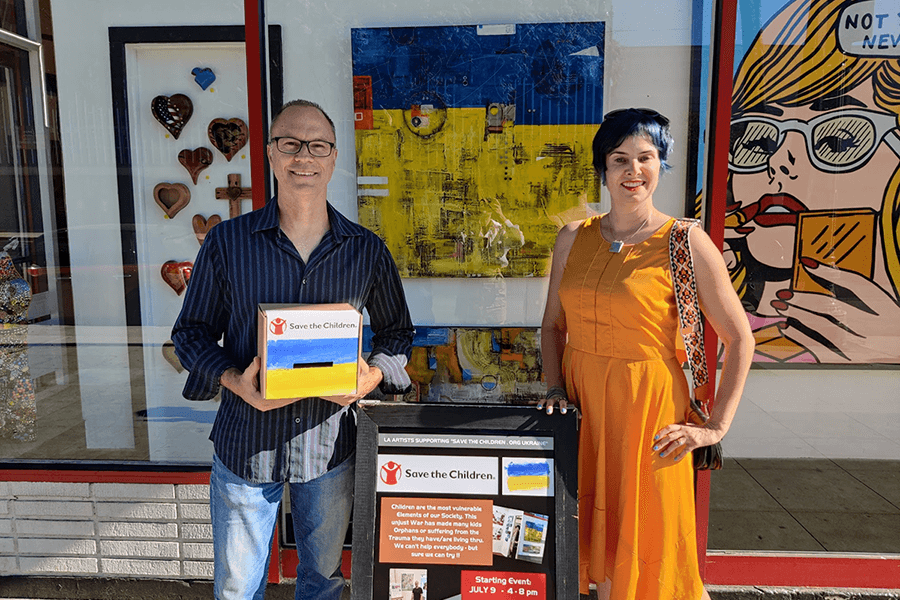
Kogan poses with fellow artist Marc Raphael during the art auction to raise funds for “Save the Children Ukraine.”
Another high-profile piece of Kogan’s is Landscape, emblazoned in the colors of the Ukranian flag with a splash of intense red near the topmost left corner. The physical canvas is a stout 40 by 40, a menagerie of harsh lines and metallic surfaces. Kogan used bullets and other pieces of hardware to create the texture, a haunting effect that underscores the brutality of the situation in her home country.
“As the war broke out, I started to see a lot of artists emphasize Ukraine, particularly by painting sunflowers. At first, I thought this was not so much my style, and the flag colors were not my palette,” Kogan said. ”But the war went on—a day, to a week, to a month—and as I was processing what was happening, I realized I had to do something to express all of my emotions about the injustice and absurdity of the situation. That piece just kind of came out, even though I didn’t plan it.”
Within a month and a half of the war’s outbreak, the piece was completed, and promptly featured in fundraisers and art shows to raise funds for Ukraine. The painting was sold to a collector in the Bay Area, and Kogan donated the proceeds from the sale to NovaUkraine and Save The Children Ukraine.
“I was overwhelmed by the support of other artists that just wanted to donate their pieces to be a part of that auction,” Kogan said. “We had a whole series of exhibitions in July.”
Kogan is grateful for the opportunity to use the exhibition at USC to raise awareness and showcase her art to a community that she was once a part of, something she believes goes above and beyond just financial support for humanitarian aid for the war.
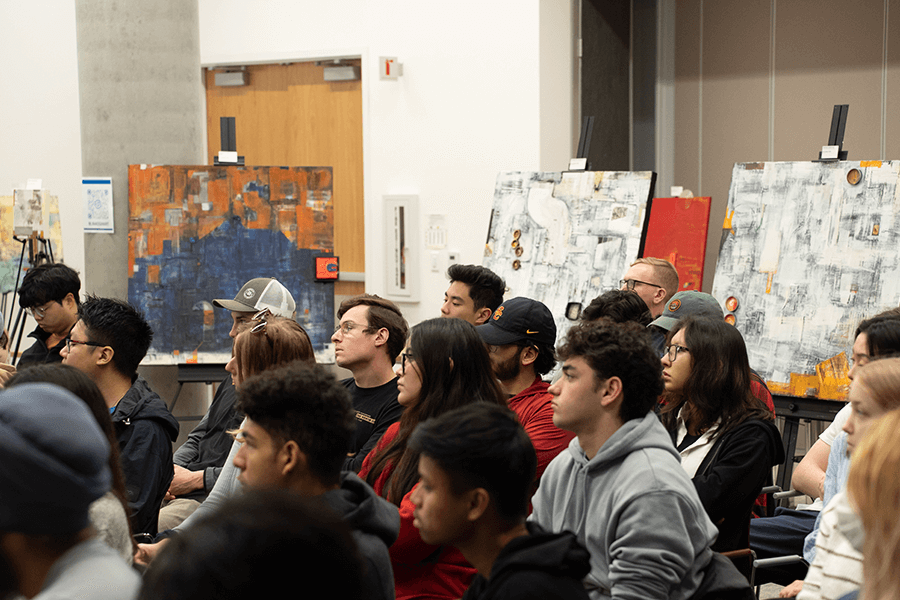
Students from both Computer Science and the Eastern European Languages department attended the Current exhibition.
“It was a very, very personal experience for me, especially because there were so many different kinds of people there, from the computer science department to those studying Russia and Ukraine,” Kogan said. “Both came up and talked to me after the exhibition, and so many people identified with those two sides converging, that creative side and that technical side. I was particularly touched by a young lady in the same boat as me, who wanted to be an artist but is studying computer science per her family’s advice. I was happy that my example showed her that it’s possible to continue on both paths without compromising either.”
The exhibition closed with a poem of hers, accompanied by another piece, Cloud Computing:
Milky clouds dissipate to reveal
The earth painted over,
patched, weathered and peeled
Build your bubble on the clouds,
metal fluffy clouds wired
with silver lining of rain 🌧️
Bubble into your Scantron
Random answers you know
That bubble up to the surface,
Come on, use your brain! 🧠
Messages are encrypted
In secure connections you made
Your magnet attracts
All you wanted to hear
All you wanted conveyed
Life computes the way you wish to feel
In your transparent fragile bubble
On the shiny brittle moving cloud
With a compelling magnetic field.
Published on March 10th, 2023
Last updated on May 16th, 2024




